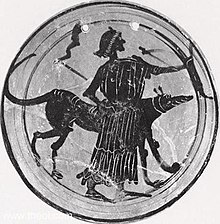User:Glorious Goddess

The Glorious Goddess
[edit]The Glorious Goddess is a very well-educated pagan Priestess, as all pagan Priestesses should be (who also has the rather problematic IQ of >175), who writes her own spells, works magic, spins her own wool, weaves her webs, gathers her pollen and stirs her cauldron regularly, and who is a fully blooming flower on an ancient and ennobled Franco-Anglo-Scots family-tree ~ a Rosa rugosa whose roots are "lost in the mists of antiquity", and whose cutting is currently planted in Australian soil, which was grafted from those in Cumbria, Lanarkshire, Argyllshire, and the Langue d'Oc, and who, by the precedent set in ancient Scots law and tradtion, has the right to style herself 'Baroness', if she wished.
Her family's various heraldries depict a rampart lion engrailed in the female line, and a crowned, or crowned and winged, "bludy harte" surmounted by a sacred pentacle or three in the male line, in both of which fleur-de-lis also appears in antiquity, as does the lion and wolf in greater antiquity. The heraldic supporters each side of her family have used have included many lions, his counterpart the panther, and a unicorn or two; the arms always have red and white mantling, and they've been surmounted by the ducal coronet on occasion, though the five-pointed coronet of earldom is much more common, but originally they all wore just the one type of crown. Her geneology can be traced to AD., 417 by any member of the public with internet-access and a credit-card, but prior to that the records are a little more exclusive for a lady likes her privacy, and she sometimes requires it.
She comes from a Wys Craeft tradition more than five hundred years old, from whose family - in one branch alone - fourteen women and two men, were put to the evil Christian pyre, the first of whom burned at the stake in the 1530s (may my Lady 'Requiescat in Pace'). She naturally objects to those writers who claim that what wicces call 'The Burning Times' never happened. One passage in the horrific Malleus Malificarum, the second most blood-soaked book in history, was written specifically for one of her family's wicces. Though another branch of her family was almost made extinct in the 8th century, and again in the 12th, and again in the 16th, each by organised Christian campaigns of mass-murder, which anyone reasonable would call 'genocide' had it not been perpetrated by the Catholic Church (as it is they merely call it protecting the faith), the latter two under the auspices of the Inquisition, today known as the Roman Catholic 'Holy Office', the former head of which now sits, whore-like, on his one remaining of the seven hills of the Papal throne. She quite naturally therefore doesn't find much that is 'holy' in that very evil institution. And it is not merely 'flawed' as they like to claim ~ because man is flawed of course. Oh no, a 'flaw' is perhaps being overly opinionated, their two thousand years of murder, rape, torture, paedophilia, lie, outright fraud and theft represents something rather more than 'flawed'.
She is a very recent newcomer to Wikipedia who intends only minor edits and open discussions, only to those pages about whose content she is knowledgable from formal study, or passionate from personal experience. She may not always quote a (supposedly) reputable source, but will not delete a statement she knows to be true and factual, but other users must remember that she may not always say how she knows what she knows.
Virginity
[edit]The word 'virgin', derived from the ancient virago, originally meant nothing more than a woman who was not currently married. For example, according to the bible a widow was a 'virgin' once more. This same usage can be seen in the literature of Ancient Egypt.

The Constellation of Hecate
[edit]It is the Goddess's opinion that originally the constellation Orionis (Orion the hunter or king to the Sumerians and Akkadians) was actually seen, by the ancient Anatolians and Greeks, as the Goddess Hecate, depicted with a "canine-like beast" at her heels (obviously Canis Major, a much smaller constellation, in which is found the brightest star in the night sky, Sirius, or Sothis [Setesh?] to the Ancient Egyptians and associated with Isa/Iset [Isis]), a bow in her left hand, out-stretched before her; and a torch in her right hand, held behind and lighting the way. This is allergorically represented in Grecian depictions such as that to the right.
It could also be argued that Setesh is associated with Isa quite possibly because the most ancient of Ancient Egyptians, the builders of the Great Temple of Isa, beside which they built the slightly smaller Temple of Usir (Osiris) and later the much smaller Temple of Set/Setesh, assocated Orionis with Isa, their Great Goddess and "Queen of Heaven", in some way. The parallels to Glorious Hecate are clear in her symbols and allegories. Which naturally begs a question or two about the greater constellation Virginis, it's Egypian usage and it's 'palm-frond'.
But it could of course be the other way around to the Ancient Egyptians, after all Virginis is the second largest constellation in the sky, greater than Orionis and second only to the Great Hydra - the watery, river-like serpent - and unlike Orionis is in the great zodiacal Wheel of the Year, and she is carrying that 'palm frond' after all. Tch, poor Usir. But maybe it's not a palm-frond at all, visualised differently it equally could be a midwife's birthing-chair, or possibly a Queen's throne.
So Just Who Is "Horus" Anyway?
[edit]The following is the story of Isa, Usir, Set and Haru as told in the Egyptian Book of "Emerging into the Light", the so-called "Book of the Dead" as it is called today, an Egyptian text of signs and wonders, and magical spells, which was codified in approximately 1550 BC.
<gallery>
File:Isis.svg|Our Lady Isa ('Our Lady' is of course ma donna in Italian, often shortened to 'Mona'; or Notre Dame in French. The grand salutation could be rendered in Italian as "La Isa" or "L'Isa", or in French as "La Ise" or "L'Ise"): A Virgin Queen of Heaven and a Mother, wife of Usir the Annointed One, after their Sacred Union took place in Spring, and Mother of Haru.
File:Standing_Osiris_edit1.svg|Usir: The Green King, born on the 25th of December and 'annointed' by Isa for kingship, and annointed for burial by her with the very costly oil of spikenard which she kept in an alabaster vessel. His burial from which, after being in his rocky tomb for three days, he is resurrected, though apparently with 'an injured foot'.
File:Set.svg|Set: The evil twin (thomas in Aramaic; didymus in Greek) of Usir, who killed him - for thirty pieces of silver.
File:Horus.svg|Haru: The Son of the Father (the father incarnate in fact) and of a widowed Lady, conceived of miracles in Spring, born to a virgin Queen after the turn of winter, and who begins to die in Autumn, only to be resurrected, or "born again", after the turn of Winter, to be married in Spring, and reach the height of his power in Summer.
File:Egypt.IsisHorus.01.png|The Virgin and Child. ... Clearly the 'Song of Solomon', an erotic poem to be read at the rites of Sacred Union (or Hieros Gamos in Greek) was not the only 'sacred story' it's 'editors' hijacked from the Egyptians. Another one, the hymn of Haru, begins with the words "Our Father, which art in heaven..."
File:Fleur_de_lys_(or).svg|The Fleur de l'Ise (or sounded word-for-word, le fleur de la Ise ~ the flower of "La Ise", something of an historical mystery, for who is or was La Ise? ... Oh yes, now I remember. So, the flowering of Isa? Curiouser and curiouser).
<gallery>
